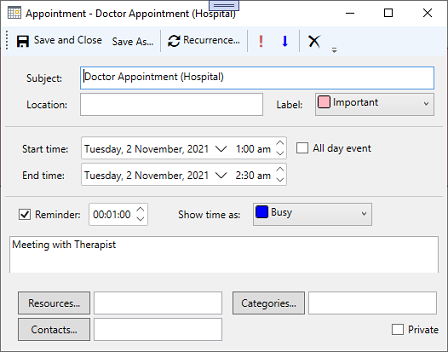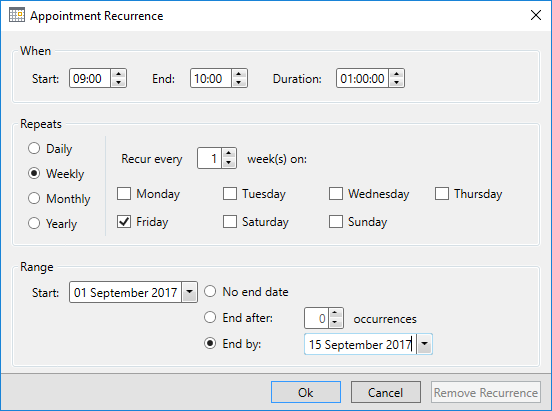Appointment Operations
Appointments can be created at run time by double-clicking the time for the appointment to begin or by pressing ENTER key, which opens the Appointment dialog box. For more information about appointments, see Appointments.

Add and Save an Appointment
Appointments can be added to the Scheduler using the Appointment dialog box.
Double-click the desired appointment time to open the Appointment dialog box, or simply press the ENTER key to create an in-place appointment.
In Appointment dialog box, specify a Subject, Location and any additional information you would like to assign to the appointment.
Click the Save & Close button to add the new appointment to the schedule.
Appointments can be also created programmatically using the Appointment class and its properties such as, Start, Duration, Body, etc. and added to the Scheduler using the Add method as showcased in the following code.
// Showing Appointment
var appointment = new Appointment();
appointment.Start = new DateTime(DateTime.Now.Year, DateTime.Now.Month, DateTime.Now.Day, 1, 0, 0);
appointment.Duration = TimeSpan.FromHours(1.5);
appointment.Subject = "Doctor Appointment (Hospital)";
appointment.Body = "Meeting with Therapist";
//Adding appointment to scheduler.
scheduler.DataStorage.AppointmentStorage.Appointments.Add(appointment);Edit an Appointment
Appointments can be changed and updated in Scheduler either in-place or through the Appointment dialog box.
Use the F2 key to edit the Subject in-place. Press the Enter key to save edited text or Escape key to cancel editing.
Double-click an existing appointment to open the Appointment dialog box. Alternatively, use the Enter key to open the Appointment dialog box of the selected appointment.
After editing all the desired fields in the dialog use the Save button on the rightmost corner of the Appointment dialog box or Ctrl+S key to update the appointment in the schedule.
You can also edit an appointment in the Scheduler programmatically. For doing so, you can add a Button control to edit an appointment and a Scheduler control to your application as shown in the following steps:
Add a Button control to edit an appointment and a Scheduler control to your application as shown in the following code:
<Button x:Name="btnEdit" Click="btnEdit_Click" Margin="5" HorizontalAlignment="Left">Edit Selected Appointment</Button> <c1:C1Scheduler x:Name="scheduler" Grid.Row="1"></c1:C1Scheduler>Switch to the code view and add the following code to add an appointment to the Scheduler and edit the appointment on the button click.
public EditingAppointment() { InitializeComponent(); InitAppointments(); } private void InitAppointments() { for (int day = 1; day <= 7; day++) { scheduler.DataStorage.AppointmentStorage.Appointments.Add(new Appointment() { Start = new DateTime(2021, DateTime.Now.Month, day), Duration = TimeSpan.FromHours(1), Subject = $"Test Appointment {day}", Body = "New Appointment" }); } } private void btnEdit_Click(object sender, RoutedEventArgs e) { if (scheduler.SelectedAppointment == null) MessageBox.Show("No Appointment selected.", "Select Appointment", MessageBoxButton.OK, MessageBoxImage.Information); else { scheduler.EditAppointmentDialog(scheduler.SelectedAppointment); // Opens edit dialog for provided appointment scheduler.SelectedAppointment = null; } }
Delete an Appointment
Selected appointments can be easily removed from your schedule through the Edit Appointment dialog box.
Select the appointment you would like to remove from the schedule.
Click the Delete key on your keyboard. The appointment is removed from the schedule.
Scheduler allows you to delete an appointment programmatically as well. For doing so, you can add a Button control to delete an appointment and a Scheduler control to your application as shown in the following steps:
Add a Button control to edit an appointment and a Scheduler control to your application as shown in the following code:
<Button x:Name="btnDelete" Click="btnDelete_Click" Margin="5" HorizontalAlignment="Left">Delete Selected Appointment</Button> <c1:C1Scheduler x:Name="scheduler" Grid.Row="1"></c1:C1Scheduler>Switch to the code view and add the following code to add an appointment to the Scheduler and edit the appointment on the button click.
public DeleteAppointment() { InitializeComponent(); InitAppointments(); } private void InitAppointments() { for (int day = 1; day <= 7; day++) { scheduler.DataStorage.AppointmentStorage.Appointments.Add(new Appointment() { Start = new DateTime(2021, DateTime.Now.Month, day), Duration = TimeSpan.FromHours(1), Subject = $"Test Appointment {day}", Body = "New Appointment" }); } } private void btnDelete_Click(object sender, RoutedEventArgs e) { if (scheduler.SelectedAppointment == null) MessageBox.Show("No Appointment selected.", "Select Appointment", MessageBoxButton.OK, MessageBoxImage.Information); else { scheduler.SelectedAppointment.Delete(); // Deletes the appointment from the scheduler. scheduler.SelectedAppointment = null; } }
Recurring Appointments
Appointments can be set to recur at specified intervals. An appointment can recur daily, weekly, monthly, or yearly.
Double-click an existing appointment. The Appointment dialog box appears.
Click the Recurrence button. The Appointment Recurrence dialog box appears.

Set the desired recurrence pattern:
When
The properties in the When group allow you to set the start time, end time, and duration of the appointment.

Repeats
The Repeats group settings change depending on whether the appointment recurs Daily, Weekly, Monthly, or Yearly.
Daily
The Daily settings allow you to repeat an appointment every specified number of days or only on working days.
 For example, setting the appointment to every 2 day(s) will make the appointment appear every other day. Setting the appointment to on working days will make the appointment appear only Monday through Friday, by default.
For example, setting the appointment to every 2 day(s) will make the appointment appear every other day. Setting the appointment to on working days will make the appointment appear only Monday through Friday, by default.Weekly
The Weekly settings allow you to repeat the appointment on every specified week on specified days.
 For example, setting the appointment to every 2 week(s) on and selecting Tuesday and Thursday will repeat the appointment every other week on Tuesdays and Thursdays.
For example, setting the appointment to every 2 week(s) on and selecting Tuesday and Thursday will repeat the appointment every other week on Tuesdays and Thursdays.Monthly
The Monthly settings allow you to repeat an appointment on every specified date at a specified interval of months or on a specified day and week of the month at a specified interval of months.
 For example, setting the appointment to on the 8 day of every 2 month will make the appointment appear on the 8th of every other month. Setting the appointment to on the third Monday of every 2 month will make the appointment appear on the third Monday of every other month.
For example, setting the appointment to on the 8 day of every 2 month will make the appointment appear on the 8th of every other month. Setting the appointment to on the third Monday of every 2 month will make the appointment appear on the third Monday of every other month.Yearly
The Yearly setting allows you to repeat an appointment on a specified date or a specified day and week of a specified month.
 For example, setting the appointment to on the 2 day of January will make the appointment appear on January 2nd every year. This setting is ideal for birthdays and anniversaries. Setting the appointment to on the first Friday of January will make the appointment appear on the first Friday in January every year.
For example, setting the appointment to on the 2 day of January will make the appointment appear on January 2nd every year. This setting is ideal for birthdays and anniversaries. Setting the appointment to on the first Friday of January will make the appointment appear on the first Friday in January every year.Range
The Range group allows you to set a time span for the recurrence.

The Start drop-down calendar allows you to select the date from which the recurrence will start. There are three options to choose from for an end date:
No end date will make the appointment recur indefinitely.
End after 0 occurrences will make the appointment recur a specified number of times. For example, if an appointment repeated every day, setting End after 25 occurrences would allow the appointment to repeat every day 25 times.
End by will make the appointment recur until the date specified.
Click Save to close the Appointment Recurrence dialog box.
Recurring appointments can also be created programmatically using the following code:
var appointment = new Appointment();
appointment.Start = DateTime.Now;
appointment.Duration = TimeSpan.FromHours(1);
appointment.Subject = "Finance Meeting";
appointment.Body = "Meeting with Mr. Willson";
appointment.Importance = ImportanceEnum.High;
// Setting Recurring pattern for appointment.
var recurrencePattern = appointment.GetRecurrencePattern();
recurrencePattern.RecurrenceType = RecurrenceTypeEnum.Daily; // will occur daily
recurrencePattern.PatternStartDate = DateTime.Now;
recurrencePattern.Occurrences = 10; // will occur for 10 days
// Adding appointment to scheduler.
scheduler.DataStorage.AppointmentStorage.Appointments.Add(appointment); Keyboard Shortcuts for Appointment
Scheduler provides keyboard options for the following actions:
Key | Action |
|---|---|
Enter | Creates new in-place appointment or opens the Appointment dialog for an existing selected appointment. |
Esc | Cancels in-place appointment editing. |
F2 | Turns on in-place appointment editing for selected appointment. |
Tab (SHIFT+Tab) | Moves selection and keyboard focus to the next or previous appointment in the current view |


